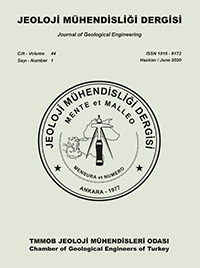The Journal of Geological Engineering is published by the Chamber of Geological Engineers of TMMOB twice a year, in June and December, since 1977. The manuscripts submitted to the journal are evaluated using peer review procedures. The Journal of Geological Engineering is indexing in Scopus, Google Scholar, TÜBİTAK-ULAKBİM TR Dizin.
Journal of Geological Engineering covers national and international researches in applied geological engineering domain such as engineering geology, geotechnics, water resources management and hydrogeology, environmental geology and waste management, geothermal, drilling techniques and applications, natural hazards, natural disasters and disaster management. Besides, interdisciplinary studies including civil, mining, geophysics, petroleum, environment, city and regional planning using geosciences data are also accepted. Unpublished original researches about aforementioned topics are published either in Turkishor English.
Manuscript submissions are accepted via DergiPark System.
To contact the editor, use the following e-mail address: jmd@jmo.org.tr
2023 HAZİRAN CİLT 47-2
ABSTRACT: Access to clean water is becoming increasingly difficult as a result of global climate change, industrialization, fast population expansion, and other factors. To safeguard fresh waters, natural lakes such as wetlands are protected,and storage water structures are erected on streams. The most important aspect influencing the life of storage water structures is the determination of the sediment entering the water reservoir. This material builds in the dam reservoir, reducing the amount of usable water and rendering essential elements such as the bottom weir or water in take structure inoperable. The spatial distribution and temporal variation of TSS were investigated in this study by using the parameters of Total Suspended Sediment (TSS), which were produced by creating a model between satellite data and terrestrial data, and Sentinel-2 satellite data from Seyhan Dam Lake, which is located in the south of Turkey,within the provincial borders of Adana. The maximum TSS concentration was determined to be 25.01 mg/L on 26.03.2020, with the lowest value being 17.65 mg/L on 23.01.2021. The TSS characteristics will be more precisely determined by samples from additional places at previously known satellite transit times, as a foundation for a system to be created for remote sensing-based TSS monitoring in the Seyhan Dam Lake. TSS values for the whole lake surface will be determined in this manner rather than TSS values for specific spots.
ABSTRACT: The water quality and quantity of coastal aquifers are increasingly adversly affected due to changing climate conditions and increasing anthropogenic activities. This study was conducted to determine the water quality and pollutants of the Erdemli Coastal Aquifer (ECA). In this study, groundwater sampling was carried out in August 2020 to determine the physical and chemical properties of the water. The obtained results were evaluated according to the World Health Organization (WHO) drinking water standards. It was found that the electrical conductivity values were quite high in samples taken from certain points near the Mediterranean coast of ECA. These samples also exhibited high sodium (Na+) and chloride (Cl−) concentrations, exceeding the recommended WHO limits. Another significant problem in the ECA is nitrate (NO3−) pollution. The nitrate concentrations in the August 2020 samples ranged from 2.17 to 131.51 mg/L, with 15 samples exceeding the limit value (50 mg/L). Some samples also exceeded the WHO-established limit values for trace element concentrations (Al, Fe and Ni). When assessing the groundwater in the study area for agricultural irrigation water quality, it was determined that waters in areas with active seawater intrusion were not suitable for irrigation purposes. The study area and its vicinity have been witnessing the opening of new agricultural areas on a daily basis. This situation further exacerbates the pressure on the declining water resources in the ECA. As a result, the implementation of sustainable integrated water management in ECA is urgently needed.
ABSTRACT: The engineering properties of a clay soil and its mixtures (5, 10 and 15% by weight) with a plaster mortar additive (PMA) were studied through a series of soil mechanical tests to investigate possibilities to improve its undesired/problematic plasticity, strength, compaction and consolidation characteristics. The tests included the Atterberg limits, shear box, compaction, consolidation, and unconfined compressive strength tests. The results demonstrated that using PMA can significantly enhance the soil properties and serve as a soil stabilizer. Adding PMA led to a decrease in the plasticity values of the soils. Moreover, it was observed that the highest maximum dry unit weight and the lowest optimum moisture content were achieved when 15% PMA was added. The soil strength properties reached maximum values when the mixtures contained 15% PMA. Additionally, an optimal coefficient of volume compressibility (mv) was obtained when the PMA ratio in the mixtures was 10%. It was concluded that the plaster mortar additive used in this study could significantly improve the geotechnical parameters of the soil.
ABSTRACT: As a result of the characteristics of Ankara Clay, such as its overconsolidated, active, highly plastic, and stiff consistency, obtaining undisturbed samples is challenging and adversely affects the reliability of laboratory test results. Due to this problem, studies in the literature have been mainly limited to shallow depths and no depth-related evaluation has been performed. Within the scope of this research, soil characterization studies related to depth have been carried out using approximately 5500 samples obtained from in-situ field and laboratory tests from clay units located in the west of Ankara at different depths. The frequency distributions of geotechnical parameters have been statistically examined, empirical equations have been developed between parameters, and the effect of sample disturbance has been evaluated. To quantify the effect of disturbance and to verify the accuracy of the identified relationships between soil parameters, laboratory test results have been compared with the existing literature, and sensitivity changes between undisturbed-disturbed and remolded samples, in terms of undrained shear strength (Cu) and liquidity index (LI) values, have been identified. Considering these studies, an approach for identifying disturbed samples has been proposed. The method was tested with validation studies using laboratory results from clayey soils with similar soil properties. As a result of excluding the samples detected as disturbed within the proposed method from the dataset, high percentages of increases have been observed in the success of predicting undrained shear strength in the empirical equations developed both in the literature and within the scope of the study. In conclusion, the present study has not only provided a detailed depth-dependent characterization of the Ankara Clay, but also a new perspective for evaluating the effects of disturbance on sensitive clay samples. These findings have practical implications, especially in civil and geotechnical engineering where soil behavior at different depths is essential for the stability and design safety of underground structures.
ABSTRACT: The Kahramanmaraş-centered earthquakes, which occurred on February 6, 2023 and have been the disaster of the century, caused the death of more than fifty thousand of our citizens and an economic loss of over 100 billion dollars, affecting Türkiye very seriously and severely disrupting the sustainable development goals. In addition to the earthquakes, Türkiye is exposed to many different types of disasters, especially floods and forest fires. Many of our citizens lose their lives every year, economic losses occur and the whole society is affected by disasters psychologically. This data shows us that policies that will combat disasters at the desired level have not yet been developed. In order to minimize the effects of possible disasters, many studies need to be carried out on different subjects and areas by looking at the event holistically. Among these studies, emergency and disaster management plans have an important place. Many regulations regarding the preparation of these plans have been made in many laws and regulations published at different times since 1945. The aim of this article is to reveal chronologically how disaster and emergency management plans have developed in the historical process, to provide information about Türkiyes Disaster Response plan dated 2014 and 2022, to guide the preparation of the plans, to contribute to their effective implementation, and to draw attention to the importance and necessity of the issue..




